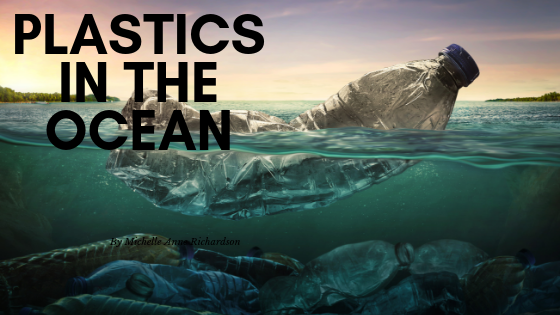
Plastics in the Ocean
When you go to the seaside one of things you are sure to see on the beach is plastic waste. In the past a lot of it was thrown overboard from ships, but that was stopped by an international regulation known as MARPOL, which came into force in 1988. Partly because of that regulation something like half of the plastic waste we see on beaches now comes down rivers or through sewage outfalls or is left there by visitors. But the rest still comes from offshore dumping by sneaky captains flouting the regulations. Altogether around 2 million tons of plastics enter the ocean every year from rivers. Probably about the same amount originates offshore.
Why is there so much of it? Well, plastic is handy stuff – these days virtually indispensible. We love it because it is light, strong, flexible, relatively inert, insoluble in water, and resistant to biological decay and much chemical attack over decades to centuries at least. Back in 1950 global production was about 2 million tons. Now it is a staggering 300 million tons! By 2015 enough of it had been produced to plastic-wrap the planet. Thankfully, many of us have woken up to the need to recycle plastic waste, though we are not helped by distributors wanting to wrap their products in at least one layer of plastic, if not more.
The big stuff we find on beaches – bits bigger than a 5p piece that you can easily see by eye - are just the tip of the iceberg. Those big bits in turn can break down over time into progressively smaller bits. Then there are the tiny lentil-sized plastic pellets known as ‘nurdles’ that are used as a raw material by industry to make new plastic products. 73% of beaches from Shetland to the Scilly Isles contain nurdles. We also have to contend with microbeads (polyethylene microspheres that are added to certain cosmetics, facial scrubs and toothpaste), And that’s not all: even smaller are the micro-plastics - fragments a few microns across - about the width of a human hair. Many of them are plastic fibres that come off your fleeces in the washing machine. Lastly there are the nano-plastics, which are typically tens of nanometres in diameter. They may be produced for drug delivery, detergents or cosmetic use, or they may be fragments of larger particles. Their large ratio of surface-to-volume increases their ability to adsorb organic compounds, like toxic PCBs. They can penetrate cell walls and have been shown to affect the growth and reproduction of some aquatic invertebrates.
Plastic waste it not just unsightly, it is also dangerous for marine life because plastic can float for years. Fish and other marine animals can become trapped in plastic ropes, discarded fishing nets and lines, plastic bags and even the plastic rings used to hold cans of beer and drinks together. It may seem odd to us, but some animals, including fish and their larvae, can mistake microplastics for food. Ingesting these non-degradable materials can cause them to starve for lack of nutrition - for instance, around 45% of the mass of Laysan albatross chicks from Kure Atoll and Oahu Island in the Pacific Ocean consists of plastic fragments. Nevertheless, on some islands such as Diego Garcia, hermit crabs have taken to using plastic bottle tops as homes. There are always winners and losers.
We now know that the oceans cannot simply absorb anything that we throw at them. That’s especially true of plastics, which float and take decades to degrade. The great ocean currents sweep up floating plastics and concentrate them into plastic garbage patches at the centres of giant oceanic eddies. One of these is the Great Pacific Garbage Patch between Hawaii and California. Another is the Sargasso Sea Garbage Patch east of the Bahamas in the Atlantic. The Pacific patch is about 3 times the area of France. It contains around 1.8 trillion objects, together weighing around 80,000 tons (equal to 500 jumbo jets). Most of it is made of hard polyethylene or polypropylene items, like the cases to mobile phones, or derelict fishing gear, the latter making up 46% of the items in that patch. Every year the gradual degradation of plastic objects by the sun, waves and animals increases the concentration of microplastics there.
Nature’s creatures are highly adaptable and some microorganisms form natural films on plastic surfaces, creating what some biologists refer to as the ‘Plastisphere’ – a new kind of microbial ecolosystem. Eventually some of the plastics make their way to the deep sea floor beneath their surface patches, commonly taken down there in sinking faecal pellets.
The rise in plastics in marine sediments helps to identify those sediments as belonging to a new era of geological time – the Anthropocene – a period in which humankind has begun to operate on the surface of the planet with the intensity of a geological force. Perhaps not surprisingly the Anthropocene is judged to have started in about 1950, the time when plastics production really took off.
While this might all seem rather remote and not stuff to worry about (out of sight, out of mind), we need to remember that if marine animals eat plastic, and we eat the animals, we get the plastic too, and the chemicals that go along with it, some of them possibly carcinogenic. There’s a good personal reason for us to clean up the ocean and keep it clean.
We also pay. The UN estimates that it costs the world some US$13 billion annually to clean up beaches and compensate fishermen for financial loss due to problems with floating plastic.
Fortunately science is on the job, and the garbage patches are beginning to be carefully mapped and characterized so as to facilitate their eventual clean-up (see www.theoceancleanup.com/great-pacific-garbage-patch/).
So, if you want to see a clean ocean and eat uncontaminated marine animals, please don’t dump your plastic waste in lakes, oceans or rivers. Take it home and send it for recycling or to landfill. It will cause much less damage there.
Dr Colin Summerhayes of Cambridge University’s Scott Polar Research Institute


